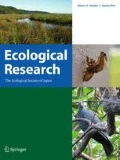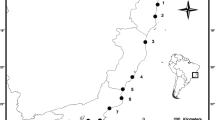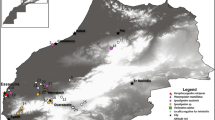Abstract
The Australian scincid lizard Egernia stokesii lives in social groups and is infected with two nematode species: Pharyngodon tiliquae and Thelandros trachysauri. This study asked whether those nematodes affected levels of lizard activity in field populations. In a laboratory colony, application of a combination of ivermectin and fenbendazole reduced nematode egg count in lizard scats after 12 weeks. In the field, the same doses of those antihelminthic drugs were applied to lizards in six social groups across three populations, and a saline control was given to lizards in six adjacent groups. Observations showed significant changes in behaviour between the two groups developing over 2 months. Drug-treated lizards spent more time basking and moved about for longer times during observation sessions. The results suggest that nematode infection altered host behaviour and reduced fitness. No influence of social group size was detected on the impact of parasitic nematodes.




Similar content being viewed by others
References
Bowman D (2003) Georgi’s parasitology for veterinarians. 8th edn. Saunders, Philadelphia, p 432
Boulinier T, Danchin E (1996) Population trends in kittiwake Rissa tridactyla colonies in relation to tick infestation. Ibis 138:326–334
Brown C, Brown MB (1986) Ectoparasitism as a cost of coloniality in cliff swallows (Hirundo pyrrhonota). Ecology 67:1206–1218
Candolin U, Voigt HR (2001) No effect of a parasite on reproduction in stickleback males: a laboratory artefact? Parasitology 122:457–464
Chapple DG (2003) Ecology, life-history, and behavior in the Australian scincid genus Egernia, with comments on the evolution of complex sociality in lizards. Herpetol Monogr 17:145–180
Cote IM, Poulin R (1995) Parasitism and group size in social animals: a meta-analysis. Behav Ecol 6:159–165
Davies CR, Ayres JM, Dye C, Deane LM (1991) Malaria infection rate of Amazonian primates increases with body weight and group size. Funct Ecol 5:655–662
de Lope F, Møller AP, de la Cruz C (1998) Parasitism, immune response and reproductive success in the house martin Delichon urbica. Oecologia 114:188–193
Duffield GA, Bull CM (2002) Stable social aggregations in an Australian lizard, Egernia stokesii. Naturwissenschaften 89:424–427
Garcia LS, Bruckner DA (1993) Diagnostic medical parasitology. American Society for Microbiology, Washington DC, p 764
Gardner MG, Bull CM, Cooper SJB, Duffield GA (2001) Genetic evidence for a family structure in stable social aggregations of the Australian lizard Egernia stokesii. Mol Ecol 10:175–183
Gardner MG, Bull CM, Fenner A, Donnellan SC (2007) Consistent social structure within aggregations of the Australian lizard Egernia stokesii across seven disconnected rocky outcrops. J Ethol (in press)
Greer AE (1989) The biology and evolution of Australian lizards. Suurey Beatty, Sydney
Hallas G, Bull CM (2006) The influence of drying time on nematode eggs in the scats of the scincid lizard Egernia stokesii. J Parasitol 92:192–194
Hallas G, Bull CM, Bursey CR (2005) Pharyngodon tiliquae and Thelandros trachysauri (Nematoda: Pharyngodonidae), new parasite records for Egernia stokesii (Scincidae) from Australia. Comp Parasitol 72:119–120
Hosseini PR, Dhondt AA, Dobson A (2004) Seasonality and wildlife disease: how seasonal birth, aggregation and variation in immunity affect the dynamics of Mycoplasma gallisepticum in house finches. Proc R Soc Lond B Biol Sci 271:2569–2577
König C, Schmid-Hempel P (1995) Foraging activity and immunocompetence in workers of the bumblebee, Bombus terrestris L. Proc R Soc Lond B Biol Sci 260:225–227
Loehle C (1995) Social barriers to pathogen transmission in wild animal populations. Ecology 76:326–335
Main AR, Bull CM (2000) The impact of tick parasites on the behaviour of the lizard Tiliqua rugosa. Oecol 122:574–581
Møller AP, Erritzøe J (1996) Parasite virulence and host immune defense: host immune response in relation to nest re-use in birds. Evolution 50:2066–2072
Moret Y, Schmid-Hempel P (2000) Survival for immunity: the price of immune system activation for bumblebee workers. Science 290:1166–1168
Nunn CL, Heymann EW (2005) Malaria infection and host behavior: a comparative study of Neotropical primates. Behav Ecol Sociobiol 59:30–37
Phillippi KM, Clarke MR (1992) Survey of parasites of rhesus monkeys housed in small social groups. Am J Primatol 27:293–302
Rubenstein DI, Hoffman (1989) Parasites and social behaviour of island feral horses. Oikos 55:312–320
Saino N, Møller AP (1996) Sexual ornamentation and immunocompetence in the barn swallow. Behav Ecol 7:227–232
Sassal P (2003) Experimental test of the influence of the size of shoals and density of fish on parasite infections. Coral Reefs 22:241–246
Schwarzkopf L, Shine R (1991) Thermal biology of reproduction in viviparous skinks, Eulamprus tympanum: why do gravid females bask more? Oecologia 88:562–569
Sorci G, de Fraipont M, Clobert J (1997) Host density and ectoparasite avoidance in the common lizard (Lacerta vivipara). Oecologia 111:183–188
Szép T, Møller AP (1999) Cost of parasitism and host immune defence in the sand martin Riparia riparia: a role for parent-offspring conflict? Oecologia 119:9–15
Vitone ND, Altizer S, Nunn CL (2004) Body size, diet and sociality influence the species richness of parasitic worms in anthropoid primates. Evol Ecol Res 6:183–199
Walter A, Lichtenstein AV (1993) Ectoparasite loads decrease the fitness of alpine marmots (Marmota marmota) but are not a cost of sociality. Behav Ecol 4:36–39
Whitlock HV (1948) Some modifications of the McMaster helminth egg counting technique and apparatus. J Counc Sci Indiana 21:8945–8949
Wilson EO (1975) Sociobiology: the new synthesis. Harvard University Press, Cambridge
Zug GR, Vitt LJ, Caldwell JP (2001) Herpetology. 2nd edn. Academic Press, Dublin
Zuk M, Kim T, Robinson SI, Johnsen TS (1998) Parasites influence social rank and morphology, but not mate choice, in female red junglefowl, Gallus gallus. Anim Behav 56:493–499
Acknowledgments
This research was funded by grants from the Australian Research Council. Phil Mayes helped with the field observations, and Gary Hallas helped with identification and egg counting techniques for the nematode eggs. Leslie Morrison looked after the laboratory colony in the Flinders University Animal Care Unit. The study was conducted according to the guidelines of the Flinders University Animal Welfare Committee in compliance with the Australian Code of Practice for the Use of Animals for Scientific Purposes.
Author information
Authors and Affiliations
Corresponding author
About this article
Cite this article
Fenner, A.L., Bull, C.M. The impact of nematode parasites on the behaviour of an Australian lizard, the gidgee skink Egernia stokesii . Ecol Res 23, 897–903 (2008). https://doi.org/10.1007/s11284-007-0453-1
Received:
Accepted:
Published:
Issue Date:
DOI: https://doi.org/10.1007/s11284-007-0453-1




